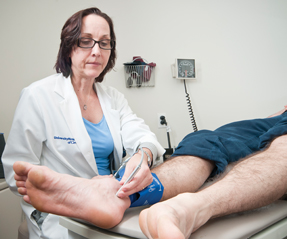Home health and hospice eligibility now requires face-to-face encounter
Enforcement begins on a new Medicare rule that mandates a personal encounter for the initial certification of home health and hospice services.
Face-to-face encounters with home health patients are no longer simply good practice, they are now required. Enforcement began April 1 for the new rule published by the Centers for Medicare and Medicaid Services that encompasses several new regulations addressing home health and hospice services, including a new home health requirement for a face-to-face encounter during the initial certification. The idea behind this is that the physician, who is most involved in the patient's treatment over the long term, is the driver of the care plan.
The required face-to-face encounter must meet the following criteria:
- A physician must have a face-to-face visit with the patient no more than 90 days before certifying the patient as eligible for home health care or within 30 days after the patient begins receiving home health services.
- Non-physician practitioners, such as nurse practitioners, certified nurse midwives and physician assistants working in collaboration with the certifying physician, are allowed to conduct this visit if they are not employed by the home health agency providing the services. However, a physician must be the one who certifies the patient's eligibility for Medicare's home health benefit.
- The physician's documentation must include who saw the patient, the date of the visit, and a description of how the clinical findings of the visit support the homebound patient's eligibility for home health services.
- Physicians and allowed non-physician practitioners who attend to the patient in acute or post-acute settings (such as hospitals or skilled nursing facilities) can certify the need for home health care based on their face-to-face contact with the patient in those settings as long as the appropriate documentation is completed. If the acute care/post-acute care physician will not follow the patient at home, that physician can initiate the orders (plan of care) for the patient's community-based physician to review and approve.
As you consider patients for home health services, remember the definition of a “homebound” patient according to Medicare:
An individual is considered to be “confined to his home” if:
- The individual has a condition due to an illness or injury that restricts the ability to leave his or her home except with the assistance of another individual or the aid of a supportive device (such as crutches, a cane, a wheelchair or a walker) or if the individual has a condition due to an illness or injury such that leaving his or her home is medically contraindicated, and
- The condition should be such that the patient is normally unable to leave home and that leaving the home requires a considerable and taxing effort.
Similarly, the hospice rules require a hospice physician or non-physician practitioner to have a face-to-face visit with each hospice patient no more than 15 days prior to the 180-day recertification period (the third benefit period) as well as each subsequent recertification. A nurse practitioner may make the visit, but the physician must certify a patient's terminal illness. The physician must sign an attestation that the visit took place and report on the clinical findings to support recertification. Documentation should include the name of the patient and the date of the visit.



